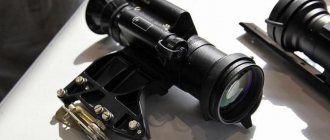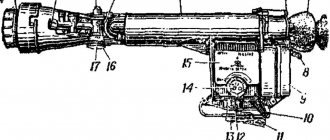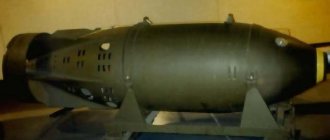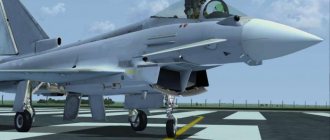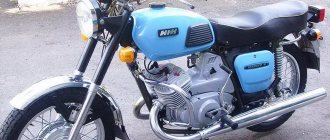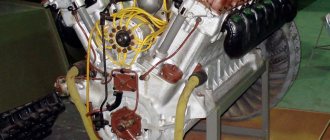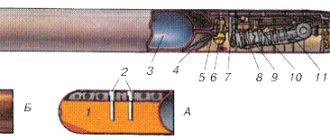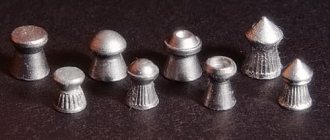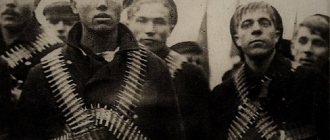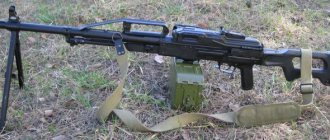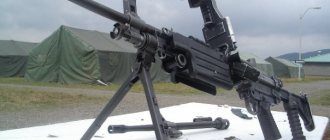| Rifle optical sight model 1931 | |
| A rifle with a PE sight in the hands of V. Zaitsev (December 1942, Stalingrad) | |
| Type | optical sight |
| A country | USSR |
| Service history | |
| Years of use | 1931 - ? |
| In service | USSR |
| Production history | |
| Constructor | VOOMP |
| Designed by | 1931 |
| Manufacturer | Leningradsky |
| Years of production | 1931—1940 |
There is an abbreviation for this term “PE”, which has other meanings: see.
Rifle optical sight model 1931
[1] or
PE
(often referred to as
Pritsel
E
Melyanov [2] or
Pritsel
Yediny
evidence been found for this [1]) - a family of Soviet optical sights from the Second World War, designed for installation on domestically produced sniper rifles based on standard Mosin, Simonov (AVS) and Tokarev (SVT) rifles[2].
History of creation[edit | edit code]
Developed by VOOMP (All-Union Association of Optical-Mechanical Industry) to replace the PT optical sight; The main goal of modernization was the introduction of mechanisms for horizontal and vertical corrections[1]. Approval for gross production at plant No. 19 took place on November 13, 1931, code PE
was assigned by order of May 13, 1933[1]. During 1932, the PE sight system underwent several changes, made mainly to the correction unit and to the shape of the lens tube[1]. By the beginning of 1933, development of the PE design was completed[1], and there were so many innovations that the plant tried to report on the creation of a “sight of the 1932 model,” but such an initiative was not supported by management[1]. Due to the presence and inscription “V. Model 1931" The PE sight in the 30s was often mistakenly called the VP or UVP sight[1].
How to choose a digital sight?
The main selection criterion is the distance and conditions of the intended hunt. Since a digital sight cannot see in complete darkness, you should be concerned about the presence or possibility of installing additional IR illumination. On a bright moonlit or starry night, additional lighting is not needed. For ease of use while hunting, you should take a closer look at sights with a built-in laser rangefinder and a ballistic calculator.
The most popular additional features among hunters and shooters:
- Possibility of installing IR illumination
- Quick change of sighting profiles
- Built-in ballistic calculator
- Connection with smartphone or tablet
- Possibility of installing a laser rangefinder
- Video recording capability
- Software Update
Production[edit | edit code]
Production was first established at Krasnogorsk plant No. 19, then transferred to Leningrad (plant No. 357 of the NKV USSR), and then expanded to the NKVD of the USSR [1]. All products were supplied to Tula (plant No. 173), where the country's only production of sniper rifles based on the Mosin and SVT systems was located [1]. Brackets, dust caps and canvas covers were also manufactured there[1]. Mounting of the PE sight on Mosin rifles was carried out using the Smirnsky bracket, similar to the PT sight [1].
In 1940, all enterprises switched to producing a more advanced sight [1], but during the war the production of PE sights was resumed [1].
In total, about 46.5 thousand PE sights were produced in Krasnogorsk and Leningrad in 1931-37, and about 120 thousand were produced in Leningrad and Kharkov in 1942-43[1].
Where can I buy?
The price of a digital sight depends on many factors. The resolution and sensitivity of the matrix, the size of the lens, the complexity of the electronics used, the presence of additional functions and other characteristics make the scope more expensive or cheaper. Whether it is worth purchasing a digital sight in used condition always remains at the personal discretion of the buyer.
Buying a new device from the Tut.ru store provides undeniable advantages:
- Warranty and post-warranty support
- Professional advice from experienced hunters and shooters
- Possibility of selecting weapon mounts from stock
- Convenient payment and delivery methods
Tut.ru is the leading store in Russia in the field of hunting optics with over 10 years of experience. In our showrooms in Moscow and St. Petersburg, you can touch digital sights with your hands, make sure of their performance and quality, and also compare models from different manufacturers. We deliver devices by courier in Moscow and St. Petersburg, or by a transport company throughout Russia. Pickup from the office and payment in installments is possible. Call or order on the official website online!
Combat use[edit | edit code]
It was actively used by the Red Army on the battlefields of the Great Patriotic War[1]. German and Finnish troops also did not neglect captured PE sights, not only with standard Soviet sniper rifles, but also with weapons of their own production[1]. For this purpose, in some cases, the sights were subjected to quite radical alterations[1].
In July 1943, comparative tests of PE, PU and captured German sights were carried out, based on the results of which it was concluded that the PU was not inferior to the PU in combat properties, and significantly superior to it in terms of weight, size, technological and operational properties [1].
Links
- Description of the NSPU night optical sight on the website www.ak-info.ru
- Description of the NSPU night optical sight on the website russianguns.ru
- Review of domestically produced night sights on the website www.bratishka.ru
- Aligning the NSPU sight and preparing it for battle
- Review of domestically produced night sights on the website www.rossiyskiy-union-engineers.rf
- Experience in using the NSPU night sight during combat operations in the Chechen Republic
- Sight 1PN58 Technical description and operating instructions
Notes[edit | edit code]
- ↑ 1 2 3 4 5 6 7 8 9 10 11 12 13 14 15 16 17 18 19 20 21 22 23 Davydov B., Savenko S.
optical of the 1920s - 1940s (Russian) // World of weapons: magazine. - 2005. - April (vol. 07, no. 04). — P. 16-23. - ISSN 1607-2009. - ↑ 1 2 Potapov Alexey.
Military optical sights // The Art of the Sniper. - Fair Press, 2005. - 10,000 copies. — ISBN 5-8183-0360-8. - Ulanov A.
Sight for a sniper-fighter (Russian) // Kalashnikov: magazine. — 2016. — March (No. 03). — P. 32-37. - Davydov B., Savenko S.
Soviet optical sights of the 1920s - 1940s (Russian) // World of weapons: magazine. - 2005. - June (vol. 09, no. 06). — P. 36-45. - ISSN 1607-2009.
Performance characteristics
Single PKM machine gun with NSPU sight Night optical sight NSPU Total weight of the scope supplied with a single spare parts - 7.5-8.1 Weight of the sight in the firing position - 2.2 Weight of the sight in the stowed position - 3.5 Overall dimensions of the sight - 495× 191×96 Overall dimensions of the transport box - 500×215×171 Magnification of the sight, no less - 3.5 times Horizontal field of view - 5.0 degrees Vertical field of view - 4.0 degrees Eye exit diameter - 5 Exit pupil relief - 50 Lens focal length - 78 Resolution - 2 arc. min Time of continuous operation of the sight with one battery - 6 hours Voltage of the battery 2NKBN-1.5 - 2.5 Volts Capacity of the battery 2NKBN-1.5 - 1.5 A/hour Operating current consumption - 0.27 Number of guaranteed charges - battery discharge cycles - 200 times
The choice of magnification depending on the type of hunting
For different types of hunting, a specific multiplicity is selected. It will depend on:
- distance to the object;
- target mobility;
- speed of movement of the animal.
Driven hunt
In this case, it is necessary to see where the object is moving, so choose a small magnification from 1x, but not more than 6x. The minimum magnification provides a wide viewing angle and convenient object search, and the maximum magnification provides detail. The picture at minimum magnification will look something like this.
Hunting from the approach
This type involves the hunter approaching the animal as close as possible, so the best option would be the average magnification: 3-9x, 2-10x, 2-8x, etc., but not more than 10x.
Ambush hunting
Distances for this type of hunting may vary. For example, when shooting at a target without rests from 200-300 meters, 10x-12x is recommended, when walking - from 3x to 9x.
For ambush hunting, constant magnification scopes are widely used.
Mountain hunting
Mountainous terrain is considered difficult for hunting, so high magnification is used here. For example, at a distance of 300-400 meters it should be 10x and higher, but such a multiplicity can be maintained using only stops, otherwise hand tremors will interfere.
Sports shooting
Sports shooting uses small targets located at different distances depending on the type of competition. In any case, it is recommended to use high magnification.
Sights with constant magnification, specially designed for sports shooting, are widely used here.
For training and practice shooting using tripods and bipods, you can use magnification from 3x to 9x.
History of sights.
Thank God, they were invented abroad, almost all of their types, with the exception of the “Russian miracle”. It must be said that the history of the sight is not very long. They appeared not so long ago; in ancient times they were not used, preferring physical and moral perfection.
Ring through sights
Historically, the first was a ring-shaped device. It was located on the stock of the weapon, with a front sight attached to it, located at the point where the bullet exited. This device was used for crossbows. Obviously, then there was a need to save ammunition.
Such devices performed especially well on smooth-bore weapons. They were often equipped with hunting rifles. They were placed close to the shooter's eye. The proximity has its advantages. In this case, you won’t be able to take a closer look at this detail; the extra light doesn’t interfere, and the aiming line becomes longer. The closest approximation is that the recoil does not hit the eye with the weapon. To eliminate this, you can use a rubber eyecup. He won't let you get too close.
To aim, you had to line up the front sight and the center of the ring. In this case, the target was not obscured in any way; a lead can be set. All attention in the process is occupied exclusively by the goal, the outline of the ring does not distract attention too much.
Open device modifications require attention to three components. In the case of the ring version, you only need to monitor the front sight and the target. Most often, the ring size does not exceed 4 mm. It is possible to insert a disc with a hole. In practice, an optical modification is obtained, since the hole acts as a lens. These models do not interfere with the target.
William Lyman's devices, which came into practice since the end of the 19th century, were very famous. They provided for adjustment of the disk in two planes. They could be installed on any hunting rifles and other types of weapons. Jeffrey's company has proposed its own version, the ring of which changes position through a thin mechanism. In this case, the aiming distance can be counted as snapping occurs. A popular invention is McCubbin with the same snapping mechanism for micrometric adjustment.
Use on modern weapons
The incredible popularity of the ring type did not go unnoticed by weapon manufacturers. The Ring company offered modern such devices. They are very similar to the options on collimators. They can’t think of anything to distract you from bad thoughts. In Ring branded products, the shooter directly observes the target and the aiming mark, projected at infinity. It has the shape of a circle if you have to shoot during the day. The mark is created by the play of light as it reflects its target. It is brighter than the target background. Moreover, there is another mark in the form of the letter T, which is generated by the built-in light source. During the day you can hardly see the second mark, it’s too light, but as soon as it starts to get dark, everything falls into place. You can aim with both eyes, which is more convenient because you don’t have to spend effort squinting. This model is universal and suitable for any weapon.
Diopter sights
Diopter varieties have become a further improvement of ring types. The significant difference was the larger hole size. The diameter can reach 50 mm, and the hole size can be 1 mm with different eye positions customary for a particular shooter.
German products have been created that provide instant reinstallation of a disk with the required hole size. An eyecup can be installed on the disc. This detail not only cuts off interfering light, but also helps protect the eye from being hit when fired.
Also of interest are the original diopter sights, which are mounted on glasses, headgear, or simply on the head if there is no cap. Narrow front sights are most suitable for through sights. Hunters prefer its rail profile. It is preferable to use this part gold-plated, silver-plated, plastic or bone. It is highlighted by a 3 mm dot.
In this regard, the Lyman option is considered the height of perfection. It rotates around its axis, allowing you to lift different types of options. Hunters do not need protective wings; they, as well as headphones, make it difficult to grab the target in the blink of an eye and interfere with visibility. It is better to use such parts in a removable version.
Collimators
This device is based on the primitive principle of optics. The sights' collimator acts as a long-focus lens with a mark illuminated by a special device. In our case, the mark is formed using a diaphragm. There are open and closed types of sights. The closed-type components are located coaxially along the line of sight. However, the overview is very limited.
Open collimators do not obscure the view. All red dot sights do not magnify. The aiming point size reaches 15 minutes. Modifications are available with a variable dot size, depending on the target and distance. Typically, all these devices produce a red color image. But it happens that it is very difficult to distinguish it. This prompted the manufacturers to release a device with a green color. Some modifications suggest the ability to easily change from one color to another.
The light intensity from the point significantly affects the process. In bright sunlight, the dot is not always clearly visible. In darkening conditions, in cloudy weather, too bright a point prevents the eye from adapting normally, and less brightness is required. This is fully taken into account in the best options for sights that have several degrees of light intensity gradation. You can select in manual mode, there are options for automatically setting the brightness.
Collimator sights are widely used on military weapons. They can have different sizes and shapes, which are dictated not by a rational principle, but by the desire for a beautiful life without the usual spitting in the West.
Holographic modifications
Collimator types of sights were replaced by holographic ones, which to a certain extent continued development in the same direction. The invention of holography has always been considered an epoch-making event that completely changed the worldview of many. A transparent hologram with laser illumination creating an image is used as an aiming field.
The product contains both traditional two-dimensional marks in the form of dots, circles, crosshairs, and a mark in the form of a volumetric line coinciding in direction with the direction of the weapon. The screen can always be replaced with a more acceptable one in a given situation. The brightness of the brand can be manually adjusted or changed automatically. Nothing interferes with the view, since there is only a frame in it. Sights of this type have exceptionally high resolution, limited by the natural physical parameters of the eye.
Open sight types
The first sights used by mankind became a significant step towards progress and improvement of weapons.
But as it turned out over time, the increased firing range made them not very practical. Then they began to use the front sight, and a little later - the rear sight. At the beginning of the 17th century, with rare exceptions, all types of weapons were equipped with them.
Permanent open sight type
The most primitive open-type sight is a crossbar. The upper cut had a slot for guidance. There is no lift in this option. This type of sight is used very rarely today; it is used for pistol shooting.
The slot is made in the shape of an obtuse or acute angle; it can be rectangular or semicircular. The triangular slot is considered the oldest, but it is not very comfortable for quick aiming. It is preferable to use a rectangular slot shape. The obtuse-angled slot allows you to instantly grab the target, but makes it difficult to control the weapon's stalling. This form of slot is often found on weapons that are used in low light conditions to ensure rapid shooting.
A shallow rectangular slot is often used on rifles. Fast and accurate shooting is well ensured by the semicircular shaped slot. The military also prefers it. The quadrangular slot has proven itself to be quite good.
Instant aiming in low light and at moving objects is successfully ensured by a shield without a slot. Only in its middle is a small line or a white line made. The shield does not block the field of view at all, it demonstrates well the weapon's stalling, and puts strain on the eyes. In this case, the front sight must be light or golden.
Front sights in the shape of a triangle, trapezoid, rectangle, or rail section are used. With gold-colored flies it is most convenient to hit an animal, since against a dark background they are very clearly distinguishable and immediately appear in the field of view.
Lifting open options
Increasing the firing range required new solutions, since a larger elevation angle was needed. For these purposes, modifications of devices with adjustment in the vertical plane of the shield began to be used.
Frame varieties
To begin with, frame sights became widespread as a type of elevating sights. They had a slot on the frame itself or on a movable product on the frame. This product - a clamp - allowed you to set the distance if you placed it near the corresponding mark. This performance turned out to be not particularly good, since they were too bulky and they constantly broke from external influences. But in general, the innovation turned out to be useful; it was possible to fire at long distances with heavy bullets at low speeds.
Searchlight sight
This unit had a dual use. It was illuminating and aiming at the same time. Already at the very beginning of the 20th century, the Germans began to produce a rifle flashlight powered by electricity. The object was attached to the barrel from below, the wires ran under the left arm. You could illuminate an object for aiming by pressing a button. It was necessary to fire without a sight; it was enough to aim the circle of light for sufficient accuracy. In practice, this invention made it possible to get into the center of the circle from 25 meters.
A little later, such a flashlight began to be equipped with pistols. Modern products of this type have high radiation power, which became possible after the advent of new lighting sources and power supplies of sufficient capacity and reliability. An example of such a device is the Hensolt sighting searchlight. It gives amazing results when applied, which cannot even be compared with anything. This spotlight is equipped with a 6 W lamp, which is enough to illuminate an object at a distance of 110 meters. The light spot is 4 m in diameter at a distance of 100 meters. The flashlight weighs about 2 kg and can work continuously for 100 hours.
Light points
Special forces and police in a number of countries use luminous devices. They are necessary at night or at dusk, in the presence of fog or smoke. The essence of the innovation is the use of luminous paint applied to the front and rear sights. One dot is usually located on the front sight, the other two are located at the edges of the sight. This greatly facilitates aiming in the absence of visibility. The Belgian company FN produces a similar product under the Tritium brand.
Light troughs
The development of devices with a glow was the gutter. It is a sighting bar with a groove, the groove is painted with a luminous composition. The target can be observed through the gap formed by the groove if the weapon is aimed precisely at it. They say that with such a device it is much easier to fire offhand.
Glowing front sight
This variation is usually used on a gun with a rib. The glow occurs thanks to activated compounds that emit light for a limited time. In addition, a fluorescent composition can be used, which glows constantly thanks to special additives.
Laser target designators
The discovery of a new device was a real revolution. New technologies have also emerged in the production of sighting equipment. Based on the use of lasers in the visible wavelength range, the use of target markers began to be practiced. The weapon is equipped with an emitter that sends light to the target in the form of a point. By adjusting the radiation, it was possible to achieve the size of the laser spot, the size of which coincided with the dispersion of weapon hits, which made it possible to determine the probability of hitting the target. These devices operate at a range of 500 meters. The disadvantage of this method is poor visibility in bright light.
But at a reduced level of illumination, the firing efficiency increases noticeably. Laser devices can operate on many working media. Recently, lasers have been replaced by pulsed LEDs. The latter have also become a significant invention of mankind and are widely used in a variety of technical devices. There are markers that operate in the invisible range of light. These devices are used as night sights.
With the development of technology, it was possible to significantly reduce the dimensions of products. This allows you to install the taps not necessarily on the weapon directly. Some devices can be placed inside, providing an ultra-small power source. For example, such a device is installed along the axis of the pistol’s return spring, if it is designed under the barrel.
IR target designators
These devices operate in the invisible infrared region of the light range. The radiation source is a laser. The devices do not harm the eyes or other organs and do not require radiation filtration. The rays are not visible to the eye, but are clearly distinguishable by night vision devices.
Features of optical sights
Gunsmiths have repeatedly made attempts to use the best inventions of mankind. They did not ignore telescopes. At the very beginning of the 19th century, telescopes were installed on two-shot Kentucky rifles. The accuracy of the result amazed the inventors themselves. The resulting weapon was superior in all respects to the modern Russian rifle, which in itself is strange and ambiguously interpreted by many literary figures.
In the mid-19th century, I. Porro proposed the use of a reversing prism. Subsequently, this system was improved by E. Abbe, and after him by Zeiss in Germany. These systems were often used on hunting rifles and to a very limited extent on military weapons.
Inspired by the excellent result, the inventors went further along the path of improving the resulting optical sights, in which they succeeded a lot.
For the first time such weapons were used during the war in North America. The snipers were commanded by Colonel Berdan, who subsequently retired from military service and invented a Russian rifle named after him. One way or another, the gradual improvement of the optical sight led to the use of sight settings based on distance, the optics became much better quality, and the device components were more accurate and reliable.
Stevens rifle
The modern optical sight arose at the end of the 19th century with the light hand of August Fiedler. Over time, these devices came to the troops of many developed countries. The use of optics played a role during the Boer War. The new product reached Russia slowly. Russian snipers had to use Mausers simultaneously with a telescope.
During the Russian-Japanese War, it was possible to find out that the Japanese had a large number of snipers in their service, but they did not know how to use optics at all. And there was no need for it, since the Arisaka rifle had good ballistics and an accurate sight. Russian weapons were not even close to the firing range of a Japanese rifle.
One way or another, with the outbreak of the First World War, per capita consumption of optical systems began to increase rapidly. Snipers in the army have become a common occurrence. They successfully replenished their ranks with new recruits.
In those days, the Mignon system appeared, which is still successfully used today. In the mid-20th century, F. Kales proposed his own optical sight, which differs from other instruments in its variable magnification. After a couple of decades, the Kales company managed to patent an innovative coating for a special type of optics.
The magnification factor of the instrument ranges from 2 X to 20 X. It is required that the aperture ratio be greater than 36, while at the dawn of optical sight construction this parameter reached a value of 100. Variable values of the parameters of the optical system make it possible to make the aperture ratio larger due to the lower magnification ratio. The first inventor who managed to achieve variable magnification was Lyapot. Over the years, the companies Ger and Zeiss made their contribution.
Today there are a huge number of modifications of sights that have the ability to change aperture and magnification. They differ in many parameters, including viewing capabilities, which are selected in accordance with the purpose of the device. It can be 2.3 degrees at 10X magnification and up to 20 degrees at 2X, respectively.
The distance for the eye on a weapon with strong recoil is chosen to be more than 9 cm. For low recoil it can be reduced and ranges from 3 cm. Two crossed threads were initially used as sighting lines. A little later, horizontal straight lines came into use, with a small dot or small stroke located in the middle. Then they began to use a horizontal straight line with a hairpin, and later only the last one. Eventually thick threads and a pin came into use.
A hairpin with a sharp tip and a horizontal straight line of increased thickness, which is interrupted in the central part of the field of view, turned out to be much more convenient. With the improvement of technology, threads fell out of use. Instead, the required shapes are simply applied to the glass.
Another improvement is the ability to install vertically, which allows you to fire at certain distances. This innovation was proposed by Feuchtländer. After him, this design was improved more than once. At first, the optical devices had a zeroing mark at 200 and 300 meters. A little later they began to use up to 4 transverse lines for different distances. Nowadays, crosshairs are movable, they are adjusted by a handwheel and allow installation at a distance of up to 1200 meters. Some rifles that have the ability to shoot at significant distances have a wider range of adjustment.
In the first versions of optical designs, horizontal guidance was not provided. The rifle's combat was verified by a telescope, the racks of which moved to the sides. When a good result was obtained, the racks were firmly fixed in this position. Errors in firing could be due to parallax. Parallax is the apparent displacement when the position of the eye changes. It leads to inaccuracies. To avoid this trouble, you need to take the same position while firing; this is largely determined by the characteristics of the butt and training.
Modern optical sights provide the ability to move the eye no more than 4 mm without parallactic errors. Similar systems are offered by the companies Busch, Kollat, and Zeiss. The dimensions and weight of optical systems have not changed since the beginning of World War I.
Durkop system
The device was proposed at the very beginning of the 20th century by E. Dyrkop. It amazes with the simplicity of the solution. Durkop's open pipe had two lenses mounted on the barrel. The lens had to be placed behind the sight in front of the front sight, and the eyepiece was in front of the sight. Fastening took place using different types of clamps.
The system had double magnification. A rifle equipped with such a device did not require zeroing. An open tube was used on any shotgun or rifle. A characteristic feature of the device was its small aperture ratio and reduced field of view. But with the simplest type of design, the gain was significant. The device was inexpensive, did not require painstaking adjustment, and zeroing was not required.
Front sight in the form of a Lily
At the dawn of the 20th century, a certain unknown H.W. described in the publication of the popular publication Field an unusual front sight that had the properties of a rangefinder, he proposed the design as an invention. In fact, a completely original and uniquely simple weapon system was described. The essence of the matter lies in a simple principle: a ring with attached wires is attached to the trunk, the contours of the latter are similar to lilies. The shot is made directly with alignment along the edge of the lily. The lily tapers in such a way that a target of certain sizes corresponds to the distance that the contours form at a given distance to a target of certain sizes.
A larger distance means that the target appears smaller and should take a lower position. This means that when firing at a significant distance, the barrel rises slightly, but the sighting system does not need to be raised. This means that the lift-up design of the scope can be easily dispensed with.
A short time later the same H.W. suggested using a drawing made on glass, and a little later - directly on the sight. The design has a certain increase.
You can do it much simpler. There is no need to draw a lily, it is enough to simply draw horizontal lines and a single vertical line running through the middle of the optics. Horizontal risks correspond to a certain distance, and it is easy to fire without raising the sighting mechanism. It is enough to point the crosshair of the desired value at the object. The only objection may be the need to take into account the distance, which makes shooting more difficult. A rangefinder of this type can be very useful only if the size of the target is known in advance. The hunter must independently take care of the flies for different game, so that the distance between the straight lines is of the appropriate width.
A little about the Russian miracle
Obvious successes in improving weapons did not go unnoticed in Russia. It turned out to be useful to stretch one’s own abilities; the Russian miracle sight was created. The famous scientist A.N. Krylov distinguished himself by offering his brainchild to public opinion for review. He replaced the huge tube on the gun with half a magnifying glass, since there was no need for the other half.
The lens was mounted so that its straight part touched the top of the conventional front sight. This system made it easier to target the target. If the target image appears in the sight slot, then aiming is completed. The significance of this proposal must be recognized. The only thing that bothered me was the extraneous light. Other negative aspects arise due to the fact that the image is seen upside down, but this circumstance was of little concern to real experts in their field, who did not care in what form the aiming object was observed.
When aiming at a target, the rifle's movements are perceived to be reversed, but this is just an illusion. Reality has proven the high practical value of the idea. Many people are unhappy with the small field of view, which makes it difficult to focus on an object or simply find it. We can only regret that the production of this original and useful contraption was never established. There must have been a huge number of reasons for this. Russia was already experiencing an era of prosperity, a silver age, and they may have missed something, but this did not affect the general state of mind.
But the innovation was noticed abroad and immediately patented. Such a device was produced by the company John Rigby and Martin, earning excess profits from the arms trade around the world.
Features of night vision sights
With the advent of the photomultiplier tube, it became possible to create effective night vision devices. During World War II, night sights were used by the American Army in the Battle of Okinawa. At that time, Sniperscope brand sights were in service. Snipers from the American side caused significant damage to the enemy, and the Japanese lost personnel of their units. The Japanese soldiers were on the verge of a nervous breakdown. All this ensured the immediate surrender of the enemy. Its use in the war with the Japanese is considered the premiere of electronics in small arms.
The first NVDs were equipped with electron-optical converters, image intensifier tubes. The operation of night vision devices required the use of infrared illumination of the target object. IR illuminators were used for illumination. A spotlight with a high-pressure xeon lamp was used as an illuminator.
The need for an illuminator increases the size and weight of the weapon. The invention of miniature devices for optimal illumination based on gallium arsenide was a success. These devices provided a sufficient divergence angle of the IR beam and an acceptable range of its action, which could be up to 800 meters. The disadvantage of systems of this kind - active devices - is that they are easy to detect by the enemy, who does not sleep and acquires his own devices that detect sources of infrared radiation. This leads to the destruction of both the radiation source and the sniper himself.
There is no such danger during hunting; for this reason, poachers destroy all animals that get in their way with great ease. But what can you do, you can’t re-educate everyone.
Capabilities of passive NVGs
All NVGs are classified by generation. The first generation includes systems equipped with a glass bulb, inside of which there was a vacuum and sputtering on the wall inside the cathode. Such a system works as an electron-optical converter, an image intensifier. After concentrating the beam of rays with a lens, they reach the cathode, which leads to electrons being knocked out. In the presence of a huge potential difference, a significant acceleration of charged particles occurs and they appear on the screen. Under their influence, the phosphor emits light. In the first devices, the gain reached 1000 with good resolution.
To increase brightness many times over, it is possible to use several image intensifier tubes, which are assembled in one housing. For three image intensifier tubes, the gain can reach 50,000. But distortion with multi-stage amplification increases significantly, and the resolution of the device decreases. Nowadays, amplification with many stages has been abandoned due to its large dimensions and significant weight.
Nowadays, small-sized devices belonging to the second generation are used, which have more advanced parameters.
Generation 1+ was the development of the idea. They began to use a fiber-optic washer. This product consists of a huge number of light guides that transmit the light signal with incredible clarity. This improves the quality of transmission at the edges, reduces distortion, and protects the image from extraneous light. Gain is provided with a factor of 1000.
The next step towards perfection was the second generation devices. They include in their design a multichannel plate, which is an amplifier - MPC. The MPC consists of more than a million channels, each with a diameter of 9 microns. A high potential is applied to the plate. The principle of its operation is simple and clear. An electron is knocked out from the cathode of the converter and enters the channel. Since the electron is accelerated by the potential difference, it knocks out additional particles from the channel wall, which also receive significant acceleration. As a result, the flow of electrons is enhanced hundreds of times. All the electrons then end up on the phosphor of the screen, creating an image. This concerns the second generation image intensifier tube. But there is also generation 2+. In this embodiment, the electrons directly end up in the plate and then hit the screen. In this design, the image intensifier is called planar. They provide smaller dimensions, higher brightness gain and better resolution. Second generation devices operate with a level of illumination corresponding to the starry sky.
The third generation operates on gallium arsenide cathodes. This innovation allows higher resolution to be achieved. These devices are expensive, but perhaps they will come up with a system that is cheaper and more practical.
Dependence of the field of view on the selected magnification
When choosing a magnification, do not forget about the field of view. With minimal magnification, it is more difficult to hit the animal, but the area is better visible, so you can easily find the object, even if it moves at high speed.
If you increase the magnification, the details of the object are better visible, shooting will be more accurate, but the field of view becomes smaller, so it is more difficult to predict the trajectory of the animal’s movement and its further behavior. And if he moves at high speed, then he can simply be lost from sight.
With a strong increase, the aperture becomes smaller, which is not entirely convenient if hunting is carried out at dusk or at night. In this case, the multiplicity must be reduced.
When choosing a scope magnification, it is better to use the average values presented in the table.
